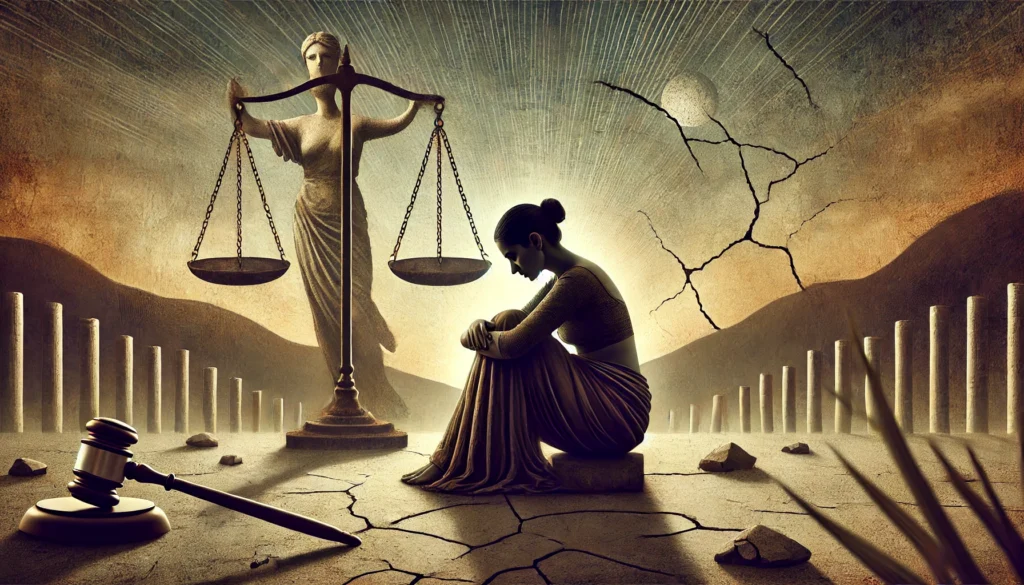Published on: 02nd October 2025
Authored By: Ritika Tawar
Delhi Metropolitan Education
1. Introduction
Indian marriage is not merely a personal contract but an institution that is legally and socially sanctioned and governed by personal laws based on religion. The Hindu Marriage Act, 1955, contains both substantive and procedural law governing Hindu marriages. Of the matrimonial reliefs it provides, Section 9, the provision for restitution of conjugal rights—has been particularly contentious. The Saroj Rani case examined whether this provision infringes upon the right to personal liberty and privacy under Article 21 of the Constitution.
2. Key Legal Facts
In Saroj Rani v. Sudarshan Kumar Chadha (1984), the appellant Saroj Rani instituted legal proceedings for restitution of conjugal rights under Section 9 of the Hindu Marriage Act, 1955, against her husband Sudarshan Kumar Chadha. The parties were lawfully married under the said Act. According to Saroj Rani’s complaint, her husband had deserted her without reasonable cause. The trial court ruled in her favour and granted the decree for restitution. However, the husband appealed to the High Court, which set aside the trial court’s order and challenged the constitutional validity of Section 9 in the context of fundamental rights under Articles 14, 19, and 21. Dissatisfied with this outcome, the appellant sought relief from the Supreme Court, which undertook constitutional scrutiny of the provision concerning matrimonial rights and personal liberty.
3. Legal Provisions Involved
Section 9 of the Hindu Marriage Act, 1955 provides that when either the husband or wife has, without reasonable excuse, withdrawn from the society of the other, the aggrieved party may apply to the District Court for restitution of conjugal rights. This judicial remedy seeks to restore harmony within the marriage and preserve the institution of marriage itself. However, its constitutionality has been challenged on the grounds that it may infringe fundamental rights under the Indian Constitution.
Article 21 guarantees the right to life and personal liberty.
Article 14 guarantees equality before the law.
Article 19(1)(d) guarantees freedom of movement within the territory of India.
Critics argue that compelling cohabitation through legal means may infringe upon these fundamental freedoms, particularly the right to personal liberty and bodily autonomy.
4. Legal Issues
- Whether Section 9 of the Hindu Marriage Act, 1955, violates the fundamental rights guaranteed under Articles 14, 19, and 21 of the Constitution of India?
- Whether granting a decree of restitution of conjugal rights amounts to coercion and infringes upon an individual’s bodily autonomy and dignity?
- Whether the enforcement of marital cohabitation by a court can be accomplished without violating a person’s right to privacy and personal liberty?
5. Arguments from Both Sides
Petitioner (Saroj Rani)
The petitioner, Saroj Rani, strongly asserted her right to avail herself of the remedy under Section 9 of the Hindu Marriage Act, emphasizing its intent to effect reconciliation between estranged spouses. She contended that the provision is essential in upholding the sanctity and stability of marriage, particularly in accordance with Hindu social values. She also emphasized the need for legal protection against unjustified desertion, arguing that without such protection, the institution of the conjugal relationship would be undermined.
Respondent (Sudarshan Kumar Chadha)
The respondent, Sudarshan Kumar Chadha, challenged the constitutional validity of Section 9 of the Hindu Marriage Act on the ground that it violates fundamental personal rights. He contended that forcing an individual to resume marital cohabitation violates personal autonomy, privacy, and dignity. Furthermore, he argued that such a provision treats the spouse as property or commodifies the marital relationship, contrary to the principles of consent and freedom of that will govern a marriage.
6. Judgment and Reasoning
Judges: Justice D.A. Desai and Justice R.S. Pathak
Decision: Appeal allowed. The Supreme Court upheld the constitutionality of Section 9.
Key Observations
In the landmark judgment of Saroj Rani v. Sudarshan Kumar Chadha, the Supreme Court of India held Section 9 of the Hindu Marriage Act, 1955, to be constitutional. The judgment, rendered by Justices D.A. Desai and R.S. Pathak, emphasized the utility of the provision in upholding the sanctity of marriage and preventing its breakdown. The Court’s rationale can be summarized through several key points:
- Restitution as a Preserver of Marriage
The Court held that Section 9 is not intended to force physical intimacy but rather serves as a mechanism for maintaining the institution of marriage. It characterized the provision as a conciliatory legal remedy designed to facilitate reconciliation between estranged spouses. The Court stated that the provision’s aim aligns with the broader public policy interest in maintaining family stability and preventing the dissolution of matrimonial relationships. Thus, the Court viewed the decree of restitution as a tool to promote reconciliation rather than as a means of imposing cohabitation through coercion.
- No Violation of Article 21
One of the strongest criticisms levelled against Section 9 was that it violated Article 21, which guarantees the right to life and personal liberty. The Court rejected this argument, holding that a decree of restitution does not entail the use of physical force or bodily coercion. Rather, where a party refuses to comply with the court’s order, the only permissible means of enforcement is attachment of property. Since no physical coercion is involved, the Court reasoned that an individual’s personal freedom remains intact and that Section 9 does not encroach upon personal liberty under Article 21.
- Distinction from English Law
The Court acknowledged that similar provisions had been abolished in English law because they were deemed inconsistent with modern concepts of individual liberty and marital equality. However, it emphasized that Indian social, cultural, and familial structures differ significantly from those of Western societies. The Court thus held that Indian matrimonial law must be interpreted in light of Indian values and customs, where the institution of marriage holds profound social importance.
- Right to Privacy
In addressing the claim regarding the right to privacy, the Court adopted a restrictive approach. It did not expand the scope of privacy in marital life as was later achieved in subsequent judgments such as Justice K.S. Puttaswamy (Retd.) v. Union of India (2017), which recognized the right to privacy as a fundamental right under Article 21. In Saroj Rani, the Court did not view restitution of conjugal rights as a violation of one’s private life and thus limited the broader implications of the privacy argument at that time.
- Equality Under Article 14
The Court observed that Section 9 is a gender-neutral provision under which both spouses have equal recourse to the court when the other has withdrawn from their society without just cause. As the remedy is available equally to husbands and wives, the Court held that it violates no principle of equality under Article 14 of the Constitution.
7. Impact and Significance
- Confirmation of Constitutional Validity
The Saroj Rani decision by the Supreme Court established the constitutional validity of Section 9, resolving judicial uncertainty that had emerged following divergent High Court decisions, such as the Delhi High Court’s ruling in Harvinder Kaur v. Harmander Singh. In doing so, the Supreme Court established binding precedent, settling the legal principle that restitution of conjugal rights is a valid remedy available under Hindu personal law.
- Marital Harmony Versus Individual Freedom
The ruling reflected the prevailing values of its time—an attempt to balance the preservation of the institution of marriage with individual freedom. The Court’s reasoning was grounded in the social context of 1984, when marriage was viewed primarily as a duty-based institution, and legal remedies were directed toward preserving marriages rather than facilitating their dissolution.
- Foundation for Privacy and Marital Rights Discourse
Although the Court did not expand the concept of privacy, the Saroj Rani case became a significant reference point in subsequent discussions regarding the intersection of privacy, consent, and marriage. It indirectly laid the groundwork for future debates on these issues in landmark cases such as K.S. Puttaswamy and in contemporary discussions surrounding marital rape.
- Gendered Implications
While Section 9 is gender-neutral in principle, its practical application has been extensively criticized on the grounds that it has been used disproportionately against women. It has often been employed by husbands against estranged wives regardless of the circumstances leading to the estrangement. Feminist scholars argue that enforcing such provisions can erode women’s autonomy and render them vulnerable to coercive domestic arrangements.
- Legal and Academic Criticism
The ruling has been criticized for failing to adequately address fundamental concerns such as bodily autonomy, informed consent, and evolving conceptions of human dignity within marriage. Critics contend that coerced cohabitation, even without physical force, places undue pressure on an individual’s mental and emotional liberty.
- Call for Legislative Reform
In light of evolving societal values, debates over gender justice, and discussions surrounding the criminalization of marital rape, some jurists and reformers have advocated for reconsideration or repeal of Section 9. Although the Law Commission defended the provision in its 71st Report (1978), recent developments have highlighted its potential conflict with contemporary human rights standards and constitutional values.
8. Comparative Perspective
In most common law jurisdictions, including the United Kingdom, the common law remedy of restitution of conjugal rights has been abolished. The UK repealed it through the Matrimonial Proceedings and Property Act, 1970, on the grounds that ordering a spouse back to the matrimonial home was contrary to principles of personal freedom, bodily integrity, and contemporary marital values. British courts increasingly recognized that such decrees were outdated and inconsistent with modern concepts of marriage as a union between consenting adults of equal status.
Indian courts, meanwhile, have retained this provision on the basis that social and cultural imperatives, particularly the need to preserve family units, take precedence. The continuation of this remedy has become increasingly problematic, however, as Indian jurisprudence has evolved to place greater emphasis on individual rights such as sexual autonomy, reproductive rights, and gender identity. Recent developments such as the decriminalization of consensual gay conduct in Navtej Singh Johar v. Union of India (2018) and growing demands for criminalizing marital rape have called into question the continued relevance of Section 9 in the current legal and social context.
9. Conclusion
The Saroj Rani v. Sudarshan Kumar Chadha judgment remains a significant milestone in Indian matrimonial law. It not only upheld an important provision of personal law but also sparked deeper debate regarding the role of courts in balancing personal laws against constitutional rights. While the Court’s ruling was consistent with the social context of its time, changing social attitudes and evolving jurisprudence may necessitate reassessment of such matrimonial remedies. As individual rights and personal liberty assume greater constitutional prominence, the question of restitution of conjugal rights remains as relevant as ever.




